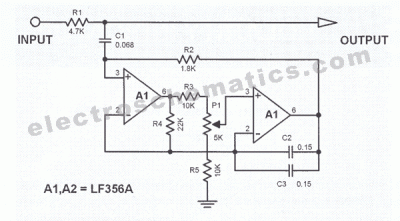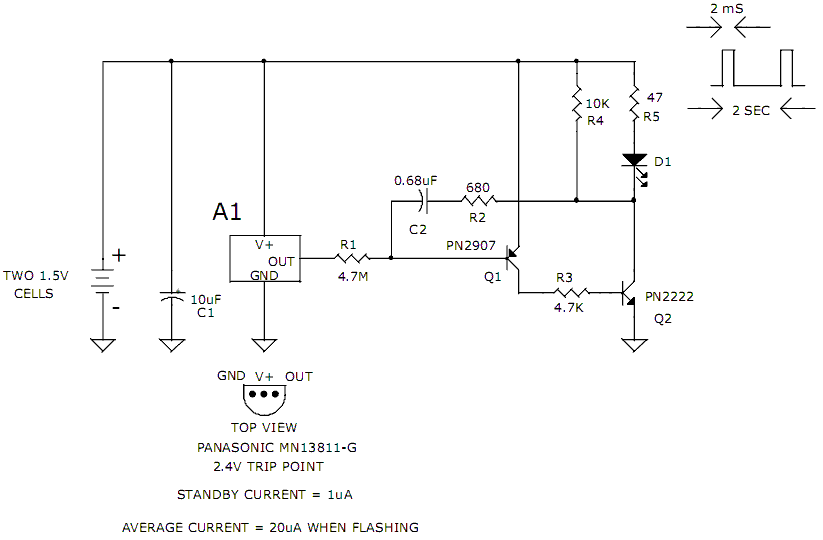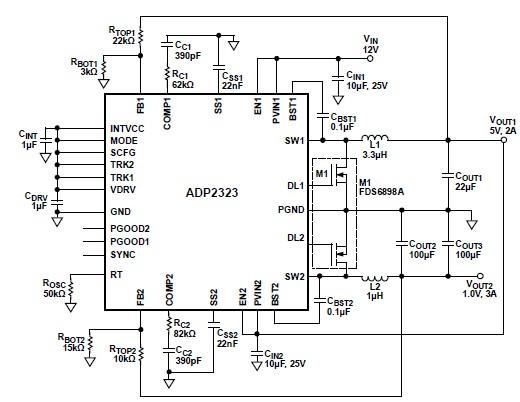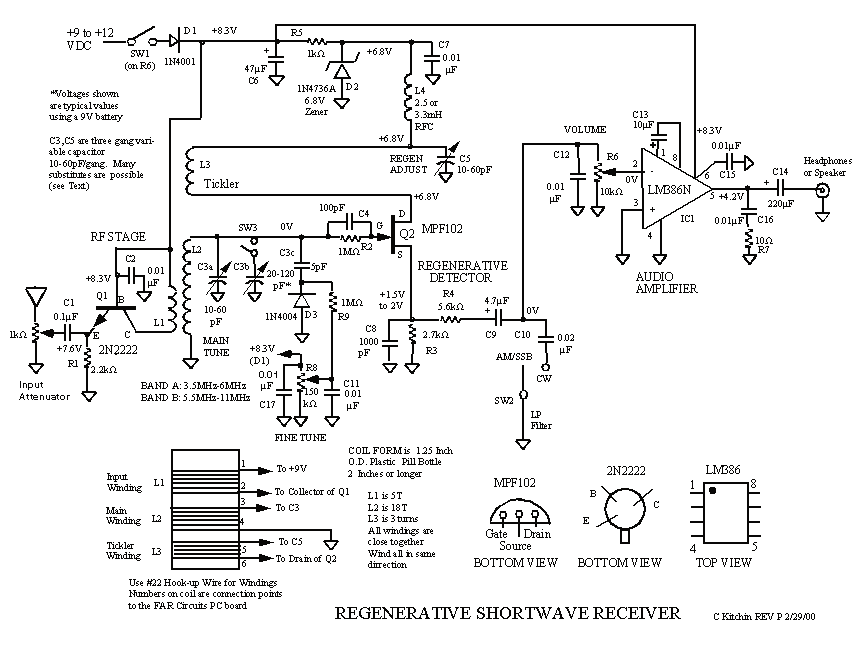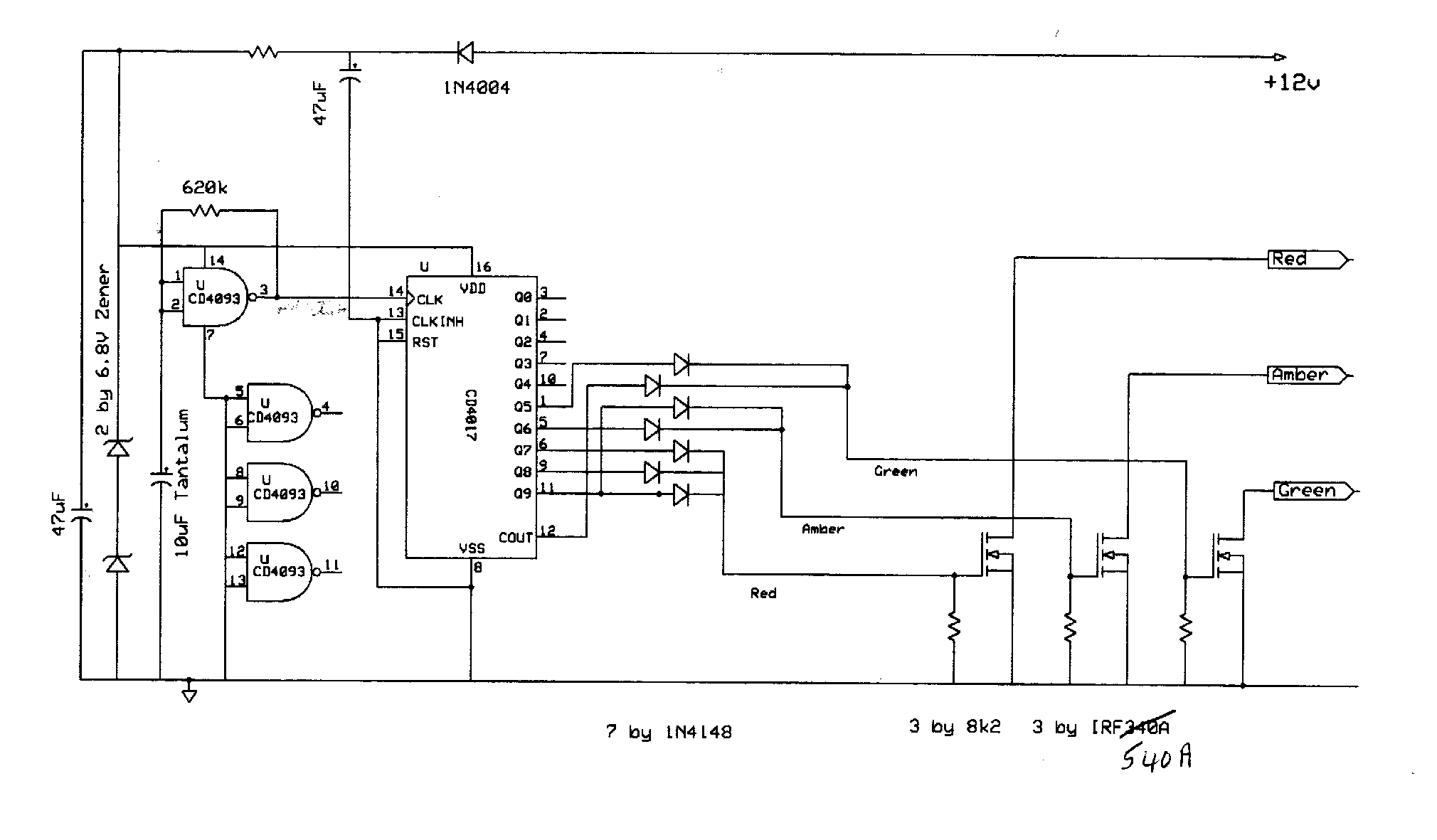
Guitar Reverb Pedal project
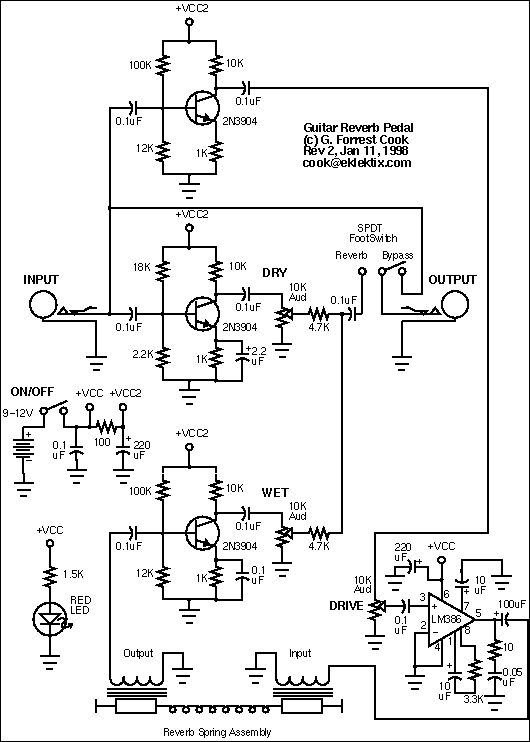
This circuit was inspired by a friend who wanted a reverb for his portable guitar amplifier. I originally tried using NE5532 low noise op-amps for the buffer stages but they were too noisy for the low level circuits so I switched to discrete 2N3904 transistors, they seem to be fairly quiet. This circuit has a nice feature not found in most reverbs, a drive control for the spring amp. The drive can be turned way up and a nice smooth distortion effect will come out of the spring. The circuit will run on a 9V battery but will probably run it down fairly quickly, it draws about 30mA idle and around 100mA with a full signal going through. Be sure to measure the DC voltage from the wall wart, they seldom agree with the label and vary a lot with load current. The circuit should work ok up to 15VDC. I built the prototype circuit right into the reverb spring box for minimal size.
The described circuit is a portable reverb unit designed for use with a guitar amplifier, utilizing discrete 2N3904 transistors for signal amplification. The choice of transistors over operational amplifiers (such as the NE5532) is significant; while op-amps are generally favored for their low noise characteristics, in this instance, the discrete transistors provide a quieter operation suitable for low-level audio signals.
The circuit features a drive control that allows the user to adjust the input signal to the spring reverb unit. This control can be set to higher levels, producing a smooth distortion effect, which is a desirable characteristic in electric guitar applications. The ability to manipulate the drive level enhances the versatility of the reverb effect, catering to various musical styles and preferences.
Powering the circuit with a 9V battery is practical, but it is important to note that the current consumption is approximately 30mA at idle and can peak at around 100mA when the signal is fully driven. This high current draw indicates that while the circuit can operate on battery power, it may deplete the battery relatively quickly, especially during extended use.
For optimal performance, it is recommended to measure the DC output voltage from any external power supply, such as a wall wart, as the actual voltage can vary based on load conditions. The circuit is designed to operate effectively within a voltage range of up to 15VDC, providing flexibility in power supply options.
The compact design of the prototype, integrated directly into the reverb spring box, highlights an emphasis on minimizing space while maintaining functionality. This approach not only conserves physical space but also likely enhances the overall aesthetic and portability of the amplifier setup.
In summary, the circuit combines practical design with functional versatility, making it an appealing choice for musicians seeking a portable reverb solution that can deliver quality sound effects.This circuit was inspired by a friend who wanted a reberb for his portable guitar amplifier. I originally tried using NE5532 low noise op-amps for the buffer stages but they were too noisy for the low level circuits so I switched to discrete 2N3904 transistors, they seem to be fairly quiet. This circuit has a nice feature not found in most reverbs, a drive control for the spring amp. The drive can be turned way up and a nice smooth distortion effect will come out of the spring. The circuit will run on a 9V battery but will probably run it down fairly quickly, it draws about 30ma idle and around 100ma with a full signal going through.
Be sure to measure the DC voltage from the wall wart, they seldom agree with the label and vary a lot with load current. The circuit should work ok up to 15VDC. I built the prototype circuit right into the reverb spring box for minimal size, it is a 🔗 External reference
The described circuit is a portable reverb unit designed for use with a guitar amplifier, utilizing discrete 2N3904 transistors for signal amplification. The choice of transistors over operational amplifiers (such as the NE5532) is significant; while op-amps are generally favored for their low noise characteristics, in this instance, the discrete transistors provide a quieter operation suitable for low-level audio signals.
The circuit features a drive control that allows the user to adjust the input signal to the spring reverb unit. This control can be set to higher levels, producing a smooth distortion effect, which is a desirable characteristic in electric guitar applications. The ability to manipulate the drive level enhances the versatility of the reverb effect, catering to various musical styles and preferences.
Powering the circuit with a 9V battery is practical, but it is important to note that the current consumption is approximately 30mA at idle and can peak at around 100mA when the signal is fully driven. This high current draw indicates that while the circuit can operate on battery power, it may deplete the battery relatively quickly, especially during extended use.
For optimal performance, it is recommended to measure the DC output voltage from any external power supply, such as a wall wart, as the actual voltage can vary based on load conditions. The circuit is designed to operate effectively within a voltage range of up to 15VDC, providing flexibility in power supply options.
The compact design of the prototype, integrated directly into the reverb spring box, highlights an emphasis on minimizing space while maintaining functionality. This approach not only conserves physical space but also likely enhances the overall aesthetic and portability of the amplifier setup.
In summary, the circuit combines practical design with functional versatility, making it an appealing choice for musicians seeking a portable reverb solution that can deliver quality sound effects.This circuit was inspired by a friend who wanted a reberb for his portable guitar amplifier. I originally tried using NE5532 low noise op-amps for the buffer stages but they were too noisy for the low level circuits so I switched to discrete 2N3904 transistors, they seem to be fairly quiet. This circuit has a nice feature not found in most reverbs, a drive control for the spring amp. The drive can be turned way up and a nice smooth distortion effect will come out of the spring. The circuit will run on a 9V battery but will probably run it down fairly quickly, it draws about 30ma idle and around 100ma with a full signal going through.
Be sure to measure the DC voltage from the wall wart, they seldom agree with the label and vary a lot with load current. The circuit should work ok up to 15VDC. I built the prototype circuit right into the reverb spring box for minimal size, it is a 🔗 External reference

